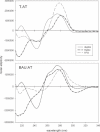Selectivity and affinity of triplex-forming oligonucleotides containing 2'-aminoethoxy-5-(3-aminoprop-1-ynyl)uridine for recognizing AT base pairs in duplex DNA
- PMID: 15317869
- PMCID: PMC516051
- DOI: 10.1093/nar/gkh776
Selectivity and affinity of triplex-forming oligonucleotides containing 2'-aminoethoxy-5-(3-aminoprop-1-ynyl)uridine for recognizing AT base pairs in duplex DNA
Abstract
We have used DNase I footprinting, fluorescence and ultraviolet (UV) melting experiments and circular dichroism to demonstrate that, in the parallel triplex binding motif, 2'-aminoethoxy-5-(3-aminoprop-1-ynyl)uridine (bis-amino-U, BAU) has very high affinity for AT relative to all other Watson-Crick base pairs in DNA. Complexes containing two or more substitutions with this nucleotide analogue are stable at pH 7.0, even though they contain several C.GC base triplets. These modified triplex-forming oligonucleotides retain exquisite sequence specificity, with enhanced discrimination against YR base pairs (especially CG). These properties make BAU a useful base analogue for the sequence-specific creation of stable triple helices at pH 7.0.
Figures







Similar articles
-
Four base recognition by triplex-forming oligonucleotides at physiological pH.Nucleic Acids Res. 2005 May 23;33(9):3025-32. doi: 10.1093/nar/gki625. Print 2005. Nucleic Acids Res. 2005. PMID: 15911633 Free PMC article.
-
DNA triple helix formation at target sites containing several pyrimidine interruptions: stabilization by protonated cytosine or 5-(1-propargylamino)dU.Biochemistry. 1999 Oct 12;38(41):13747-58. doi: 10.1021/bi9911637. Biochemistry. 1999. PMID: 10521282
-
Combining nucleoside analogues to achieve recognition of oligopurine tracts by triplex-forming oligonucleotides at physiological pH.FEBS Lett. 2005 Dec 5;579(29):6616-20. doi: 10.1016/j.febslet.2005.10.056. Epub 2005 Nov 9. FEBS Lett. 2005. PMID: 16293248
-
Stable recognition of TA interruptions by triplex forming oligonucleotides containing a novel nucleoside.Biochemistry. 2005 Apr 19;44(15):5884-92. doi: 10.1021/bi050013v. Biochemistry. 2005. PMID: 15823047
-
Targeting DNA with triplexes.Curr Med Chem. 2000 Jan;7(1):17-37. doi: 10.2174/0929867003375506. Curr Med Chem. 2000. PMID: 10637355 Review.
Cited by
-
Secondary binding sites for heavily modified triplex forming oligonucleotides.Nucleic Acids Res. 2012 Apr;40(8):3753-62. doi: 10.1093/nar/gkr1119. Epub 2011 Dec 17. Nucleic Acids Res. 2012. PMID: 22180535 Free PMC article.
-
Triplex technology in studies of DNA damage, DNA repair, and mutagenesis.Biochimie. 2011 Aug;93(8):1197-208. doi: 10.1016/j.biochi.2011.04.001. Epub 2011 Apr 11. Biochimie. 2011. PMID: 21501652 Free PMC article. Review.
-
Unnatural bases for recognition of noncoding nucleic acid interfaces.Biopolymers. 2021 Jan;112(1):e23399. doi: 10.1002/bip.23399. Epub 2020 Sep 24. Biopolymers. 2021. PMID: 32969496 Free PMC article. Review.
-
Development of bis-locked nucleic acid (bisLNA) oligonucleotides for efficient invasion of supercoiled duplex DNA.Nucleic Acids Res. 2013 Mar 1;41(5):3257-73. doi: 10.1093/nar/gkt007. Epub 2013 Jan 23. Nucleic Acids Res. 2013. PMID: 23345620 Free PMC article.
-
Selectivity and affinity of DNA triplex forming oligonucleotides containing the nucleoside analogues 2'-O-methyl-5-(3-amino-1-propynyl)uridine and 2'-O-methyl-5-propynyluridine.Org Biomol Chem. 2008 Nov 21;6(22):4212-7. doi: 10.1039/b810709b. Epub 2008 Sep 23. Org Biomol Chem. 2008. PMID: 18972052 Free PMC article.
References
-
- Chan P.P. and Glazer,P.M. (1997) Triplex DNA: fundamentals, advances and potential applications for gene therapy. J. Mol. Med., 75, 267–282. - PubMed
-
- Gorman L. and Glazer,P.M. (2001) Directed gene modification by triple helix formation. Curr. Mol. Med., 1, 391–399. - PubMed
-
- Praseuth D., Guieysse,A.L. and Hélène,C. (1999) Triple helix formation and the antigene strategy for sequence-specific control of gene expression. Biochim. Biophys. Acta, 1489, 181–206. - PubMed
-
- Neidle S. (1997) Recent developments in triple-helix regulation of gene expression. Anticancer Drug Des., 12, 433–442. - PubMed
-
- Vasquez K.M. and Wilson,J.H. (1998) Triplex-directed modification of genes and gene activity. Trends Biochem. Sci., 23, 4–9. - PubMed
Publication types
MeSH terms
Substances
LinkOut - more resources
Full Text Sources
Miscellaneous

